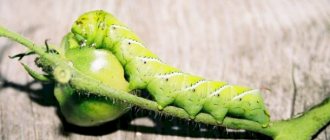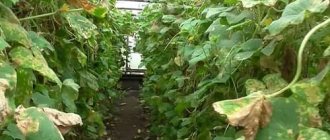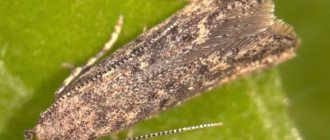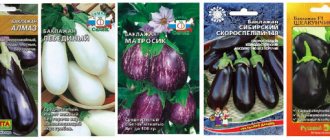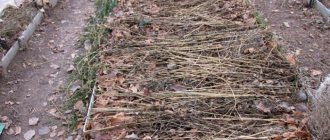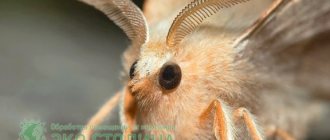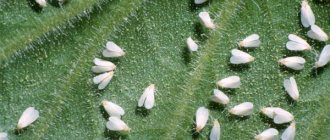An insect with the rare name Tuta absoluta from the Lepidoptera family, which is better known to us as the South American tomato moth, is the main pest of tomatoes in South America, where the larvae of this insect, feeding on the leaves and fruits of tomatoes, cause considerable damage.
Since the first discovery of this pest in Europe - in Spain, in 2006, the insect has quickly spread through Southern Europe, reaching our regions. The South American tomato moth is a type of pest that appeared in our country relatively recently and requires sufficient attention due to its high adaptability to the environment and reproduction rate.
Our article today is dedicated to the tomato moth, in which we will tell you what this pest is and also describe the main possible methods of control. The information will be useful for all residents of the southern regions of our country, as well as areas bordering them.
Geographical distribution
The tomato leaf miner is a common pest for Central American countries, which in the second half of the 20th century spread to the entire South American continent and the countries of Southern Europe. The tomato moth has been recorded in Bolivia, Brazil, Chile, Colombia, Ecuador, Paraguay, Uruguay and Venezuela, so it can be argued that the insect thrives in regions located at an altitude of less than 1000 m above sea level.
In Europe, the moth first appeared in Spain in 2006, where it is currently the predominant pest of tomatoes. It is necessary to take into account the fact that these countries are today considered the main suppliers of export tomatoes, including Turkey, from where tomatoes are brought to us. Algeria and Morocco, which also regularly supply Russia with this type of vegetable, reported outbreaks of tomato moth in 2008.
Tuta absoluta also grows actively in Italy, France and Tunisia. All European “records” of this insect, to date, have been registered specifically on tomato crops, without signs of damage to other plants.
On the territory of the Russian Federation, the tomato moth was first discovered in 2008, during an inspection of exported products from South America and Turkey. As an established pest, the insect was discovered in the Krasnodar region in 2010. By the end of 2011, tomato moth larvae were already found everywhere by farmers in the Republic of Adygea, Dagestan and Bashkiria, both in open ground and in closed greenhouses. Among the neighboring countries, Belarus, Ukraine and Lithuania are in the high-risk zone.
Signs of infection
You can understand that a plant has been attacked by a tomato leaf miner by the following signs:
- leaves turn yellow, become deformed, curl;
- fruit ripening occurs unevenly;
- the tomato pulp becomes discolored;
- Many small holes appear on the leaves.
The surest evidence is the presence of insects. If you touch the bush, a cloud of midges will flutter from it, and caterpillars can be found on the underside of the leaves.
Tomato moth or whitefly?
Inexperienced gardeners, noticing damage to the bushes, begin to look for remedies for tomato moths. However, in many cases the pest found on tomatoes is whitefly, small white midges.
Attention! Insects can be distinguished not only by color, but also by size (the whitefly is much smaller - 1...3 mm).
Tomato moth larvae gnaw passages inside the plant tissue, and whiteflies suck the juice out of it. In addition, a plant affected by whitefly is characterized by a sticky whitish coating on the leaves.
What harm can the tomato leaf miner cause?
Tomato moth poses a threat to plants such as:
- tomatoes;
- Bell pepper;
- eggplant;
- beans;
- potato.
Damaged vegetable
Moth larvae are active during the entire growing season of tomatoes and other crops, from seedlings to adult plants with ripening fruits. The larvae gnaw through all parts of the plant - stems, leaves, fruits. Affected bushes wither, dry out, and develop a bacterial or fungal infection. As a result, the crop dies.
Nature of damage
As with other insect pests of the large moth family, damage to human activities occurs due to the activity of the larvae. Adult tomato moths are not harmful to tomato production. The larvae, actively feeding, literally bore leaves and fruits, thereby producing extensive and deep tunnels, causing significant losses in the yield of protected and open ground.
Photos along the way will tell you what the above-ground part of plants looks like after the activity of the tomato moth.
A characteristic feature of this type of insect is that the larvae feed on mesophilic leaf tissues and, as a consequence, the formation of irregularly shaped “mines” on its surface. Therefore, the South American tomato moth is often called the tomato leaf miner. As a result, after the activity of the pest, tomato leaves begin to resemble translucent gauze, while maintaining their shape. The amount of such damage can reach up to 100%, and throughout the entire tomato growing cycle.
It is worth noting that Tuta absoluta is characterized by a fairly high ability to reproduce. One butterfly can bring up to 10-12 generations per year, under favorable conditions. In addition, larvae are extremely unlikely to enter a state of diapause as long as a food source is available.
Other characteristics of the pest’s life include the following:
- Moths can overwinter at any stage of their life cycle—egg, pupa, or adult. Although for those regions where this type of insect lives, the concept of “overwintering” is quite arbitrary, it would be more accurate to put it - to wait out the absence of tomato bushes.
- An adult female can lay hundreds of eggs during her entire life, and given the rapid maturation of the offspring, during the season one butterfly alone can bring thousands of small worms that actively eat tomato crops.
- Tomato bushes can be attacked at any stage of their growth - from seedlings to mature plants. The main thing is that there is a green mass of leaves.
- The moth attacks the apical buds of the plant, leaves, stems, flowers and fruits. In a word, the entire above-ground part of the culture, which is then, among other things, strewn with a large amount of black dried excrement.
As noted above, tomato moth pests reduce the yield and quality of tomato fruits grown in a greenhouse or in open ground. During mass attacks of the pest, tomato fruits lose their commercial value, and such losses can amount to 50-100% of the entire cultivated area.
Because the larvae are pests that often feed inside the fruit, it is difficult to achieve effective control when using chemical insecticides. In addition, the butterfly’s body is able to quickly develop resistance to various types of chemicals, therefore, as a rule, after 1-2 years, populations appear with reduced sensitivity to insecticides that were previously effective.
Dangerous Tourist: How Travelers Become Mass Murderers
Tuta absoluta is the Latin name for this insect pest that came to our latitudes from the American continent.
Inconspicuous, like all moths, it blends in with its surroundings, making it difficult to detect. This was the reason for the penetration of the South American leaf miner into Europe, both with tomatoes affected by it and on packaging and containers. The tomato moth also travels on other nightshades - potatoes and eggplants. This insect can cover relatively short distances independently with the help of passing air currents. This moth is called a mining moth because it forms so-called mines on various parts of the plant - voids in place of gnawed out parenchymal tissue. Outwardly, they look like patterned spots, and inside these passages there are pupated caterpillars
It is important to differentiate the pest in time, since the description of the mine is similar to damage caused by other insects
The more favorable the environmental conditions (air temperature within 22-28°C, humidity up to 80%), the higher the likelihood that the pest will multiply extremely actively and, accordingly, devour tomato plantations. If, in addition, there are no natural enemies of the tomato moth, then the likelihood of destruction becomes more than real - especially considering that the females begin to mate almost immediately after leaving the cocoon, and during the season they can make at least 10 clutches of 150-250 eggs each .
This quarantine pest first tasted European tomatoes at the beginning of the 21st century, starting its catastrophic march from Spain. How Tuta absoluta crossed the Atlantic Ocean is unknown, but it was soon discovered in Holland, Germany and other countries of Eastern Europe, and then in the former Soviet republics. And wherever it appeared, the tomato plantings were destroyed at best by half, but more often the absolute mulberry, starved during the journey, attacked the tomato plantations with all mercilessness. And farmers were left to state that their crops were completely destroyed and something needed to be done.
Brief Developmental Biology
Tuta absoluta is a pest with high reproductive potential. In addition to the fact that a butterfly can produce about 10-12 generations per year, each of which contains up to 300 eggs, the full biological cycle of the insect is completed in just 30-35 days.
Adults are predominantly nocturnal and hide between leaves during the daytime. Their body size is about 5-7 mm, with a wingspan in adult females up to 8-10 mm. The eggs of the tomato moth are small, cylindrical, creamy white to yellow, difficult to see with the naked eye - 0.35 mm. Hatching occurs 4-6 days after oviposition has taken place.
The larvae are cream-colored with a characteristic difference in the form of a dark head. During the growth process, this stage of the insect's life goes through four stages of maturation. If there is food, the larvae never enter a state of diapause. This sign further complicates pest control. Pupation can occur in the soil, on the surface of leaves, or in tunnels made in the fruit.
The most important identifying features of an adult butterfly are the thread-like antennae, which are silver-gray in color, and the distinctive black spots on the forewings. The larvae change color as they mature, making it possible to predict the time of pupation. In the first stages of growth they are transparent green and then become light pink. The larval period is the most destructive for tomatoes, which ends in 12-15 days.
What species threaten the garden?
In total there are more than 30 species of moths. Many species live in our apartments and populate wardrobes. But we will talk about creatures that pose a direct threat to plants in the garden.
| View | Description | Peculiarities |
| Potato. | The butterfly is gray-brown in color with a wingspan of up to 12-13 mm, the size of the insect at rest is only 7-8 mm. | The larvae eat tunnels in potato tubers and lead to the death of the fruit. |
| Onion. | Brown color with large white spots, elongated body with visible drooping. | Reproduction occurs in May, insects lay eggs on the back of the leaf, and the caterpillars actively destroy the leaf mass. |
| Cabbage. | Large in size, up to 12-16 mm long, with a wide stripe of white or yellow color running along the wings. | Green caterpillars eat cabbage heads, making long strokes in them and leading to the death of the fetus. |
| Tomato (mining). | A butterfly up to 5-7 mm long, with a wingspan of up to 10 mm, beige in color with brown spots. | The caterpillars attack tomato varieties, potatoes, peppers and eggplants. |
| Apple (ermine). | The butterfly is white with noticeable black dots on the wings. | It poses a danger to all types of garden trees, eating leaves and gnawing fruits. |
| Grape (circle). | Small in size with a wingspan of only 3.5-4 mm, brown in color with light-colored spots. | Caterpillars destroy grapevines. |
| Wax (bee moth). | The moth is large in size, up to 35-38 mm in length, gray-brown in color with dark spots. | The larvae can destroy all beekeeping products - royal jelly, bee bread, propolis, honey and even pollen. |
| Poplar. | A butterfly with narrow, velvety, whitish wings with dark spots on the front legs; the wings are framed with downy fringe. | The caterpillar poses a threat to all green spaces, both shrubs, trees and flowers. |
| Rowan (variegated). | The moth is 7.5-8 mm in size and grayish in color with visible dark stripes on the wings. | Causes damage to many garden cultivated trees, affecting foliage and fruits. |
| Currant (bud). | The butterfly is small in size and reaches a length of up to 12-16 mm and is yellowish-brown in color. | Eats plant buds, leading to their death. |
All varieties of moths cannot tolerate low temperatures and die when the temperature drops below +20⁰C.
Tomato moth: control measures
As already noted, the fight against tomato moth presents certain difficulties. In countries where this pest is one of the first places in plans for the development of control measures, the method of pheromone traps is actively used. Using this method, they learned to monitor and catch pests, concentrating them in one place for the convenience of subsequent physical destruction.
Traps based on the Qlure-TUA pheromone are ideal for mass capture of pests, especially when growing tomatoes in protected soil.
This approach helps to significantly reduce the pest population in greenhouses, especially if fine mesh nets are additionally used at the entrance. Mass trapping of moths involves placing a large number of traps in various strategic positions to remove a sufficiently large number of male insects from the pest population.
The pheromone method is widely used in combination with other control methods to achieve acceptable levels of damage and reduce dependence on insecticidal treatments.
Due to the small distribution of tomato moths in tomato growing conditions in Russian regions, pheromone traps are an exclusive method that is practically not available to a wide range of consumers.
Greenhouse protection
For greenhouses, which are closed spaces, other methods of combating tomato moths are used. They are able to both prevent the spread of the parasite and stop its reproduction.
All countermeasures should be carried out consistently, from the very beginning of planting plants in greenhouse conditions:
- Carrying out treatment of the greenhouse immediately before planting seedlings.
- Plants purchased at markets are recommended to be kept in quarantine for 10 days.
- Predatory insects are brought into the interior of the greenhouse, which eat the larvae, preventing the spread of the pest.
- For prevention, it is recommended to spray the seedlings with a special infusion, it is made on the basis of pharmaceutical chamomile.
In any case, if a tomato moth is detected in the greenhouse, it is recommended to take emergency measures. Chemical treatment of plants should be carried out immediately, otherwise a significant part of the harvest may be lost.
Biological methods
The tomato moth has quite a lot of its own predators, the use of which in the fight against the pest brings a certain degree of success. However, as in the case of pheromones, this method of control is little used in our country, at least for now. Below is a list of actively used living organisms for which tomato moth larvae are the main source of nutrition or maintenance of their genus. More detailed information about these living organisms can be found in additional sources:
- Trichogramma pretiosum.
- Trichogramma achaeae.
- Macrolophus tais.
- Nesidiocoris tenuis.
- Nabis pseudoferus
It is worth noting that the activity of the Trichogramma fly shows the greatest effectiveness in biological control of tomato moth - the effect of destroying the pest reaches 91.74%.
Microbial control with Bacillus thuringiensis shows satisfactory effectiveness against tomato leafminer infestations in countries where this pest is most common. In addition, the entomopathogenic fungus Metarhizium anisopliae may be responsible for the 37.14% mortality rate of female moths. cases, and Beauveria bassiana can cause 68% larval mortality.
Among plant insecticides, neem seed extract containing azadiractin, which acts as a contact and systemic insecticide against tomato moth, shows a good effect. When soil was treated with a formulation containing neem oil, 50-100% larval mortality was recorded. Applying oil to the surface of tomato leaves gives the same result. But treatment of the larvae themselves with a solution shows comparatively lower results.
Prevention of occurrence
The best method for eliminating tomato moths is countermeasures that prevent its appearance. This means that you should beware in advance of the appearance of such a dangerous enemy and create the least comfortable conditions for his stay.
- A detailed inspection of seedlings helps prevent the emergence of adults that are capable of bearing offspring.
- The slightest signs of oviposition are a reason for a methodical inspection of the leaves, which should be carried out immediately.
- Experts recommend removing damaged plants and collecting fallen leaves from tomato bushes. Then they are burned along with the larvae.
- It is recommended to carry out a preventive inspection procedure at the beginning of each season.
- Attention should be paid to both damaged tomato bushes and surrounding plants.
Note: one of the most effective drugs for combating tomato moths is halo oil; the product allows you to destroy 100% of pests.
Chemical control
Frequent intensive use of insecticides leads to the development of insect resistance to the effects of insecticides. In particular, already in the second year of use, resistance to the pyrethroid group of drugs, for example, methamidophos and cartap, appears. However, there are also long-lasting active ingredients that have been shown to be effective against tomato moth larval infestations.
These include imidacloprid, indoxacarb, spinosad and deltamethrin. However, it must be remembered that the use of products of this series is limited to use only on tomato leaves, since their accumulation in the tunnels made by the larvae in the fruits can be harmful to human health.
Alverde drug against Tuta Absolutes
Alverde (metaflumizone) is a fairly new drug whose action is almost identical to Avant (indoxocarb). It is effective in treatments, especially with oil, but cross-resistance between it and Avant is possible.
There are a large number of drugs that are being tried to be used against Tuta Absoluta, but the effect of using many of them is not worth the money spent. Based on my own observations and the experience of colleagues, I can say that Vertimek (abamectin) has practically no effect on Tutu Absolute, as well as Proclam (emamectin benzoate), although many use them.
Lannat is an old, very harsh drug that is not compatible with bioagents and is ineffective against Tuta Absoluta, so its use does not bring the desired result. Exirel is another drug that can be used against tomato leafminer, but it is registered for the control of whiteflies. It does not work against Tuta Absolute. There is information that Exirel is effective against thrips, but we did not notice such an effect of the drug.
Tuta absoluta - distribution and harmfulness
Protection against tomato leaf miner in the greenhouse
Cross resistance of tomato leaf miner to drugs
Good Agricultural Practices
Compliance with tomato cultivation practices has a significant additional effect in the fight against the South American tomato moth. Top of the list is growing non-nightshade crops next to tomatoes, annual deep plowing, timely irrigation, destroying affected plants and cleaning up plant debris in the fall.
Additionally, crop rotation and removal and destruction of infested plant material are important control practices that would help eradicate this pest in greenhouses.
Maliciousness
Tuta absoluta caterpillars damage tomato plants throughout the entire growing season, from emergence to fruit ripening. They feed on all above-ground plant organs: leaves, stems, flowers, ovaries and fruits. A characteristic sign of damage is the formation of mines on the populated organs, which look like spots. Inside such a mine is a caterpillar that feeds on tomato tissue. Once on the fruit, the caterpillar penetrates deep inside it and contributes to its rotting, significantly reducing the quality of the crop. The rapid development of the phytophage under favorable weather conditions can nullify all the owner’s efforts to obtain a tomato harvest - it can be completely destroyed in a fairly short time. That is why the South American tomato moth is recognized as one of the most dangerous and harmful organisms in world agricultural practice, especially taking into account the difficulties that arise in the fight against it. Foreign scientists on phytopharmaceutical protection note the high rate of adaptation of the pest to various insecticides, and its resistance has not yet been completely overcome. In addition, the fight against moths is complicated by its hidden lifestyle and feeding inside plants.
Preventive actions
Do you carry out moth prevention in your garden?
Constantly! I want to start
All varieties of moths are united by a common factor - this is the stage of development of the insect in the form of a pupa. Females lay eggs in the top layer of soil or on tree bark
Therefore, the most important measure is thorough autumn digging of the soil and regular cleaning and bleaching of tree trunks
All plant debris (leaves, fallen fruits and tops) are removed and then burned. Skeletal branches of trees are washed with special hard brushes (they scrape off clutches of moth eggs).
If insect larvae and eggs are found on young plant branches, they must be removed and burned.
Helps get rid of garden moths and birds. They should be attracted to the garden by birdhouses and feeders with regularly replenished food supplies. Starlings especially love to feast on the larvae and caterpillars of the parasite.
Garden moth is a dangerous pest. The greatest damage is caused by moth larvae and caterpillars. If you detect even minor manifestations of infection and individuals fluttering in the garden, you must immediately begin the fight against this voracious and omnivorous pest.
- Lacewing: description of the insect, overview of the benefits on the site and in the house, how to get rid of it in the apartment
- How to get rid of mosquitoes on your property, an overview of the main methods: insecticides, repellent plants, devices, treatment, traditional methods, the pros and cons of these options
- How to get rid of cabbage butterflies: what it looks like, what it prefers, an overview of mechanical, chemical and folk methods of control, their pros and cons
- How to deal with carrot fly: description of the pest, signs of infection, what crops it affects, review of chemicals and traditional methods, prevention tips
